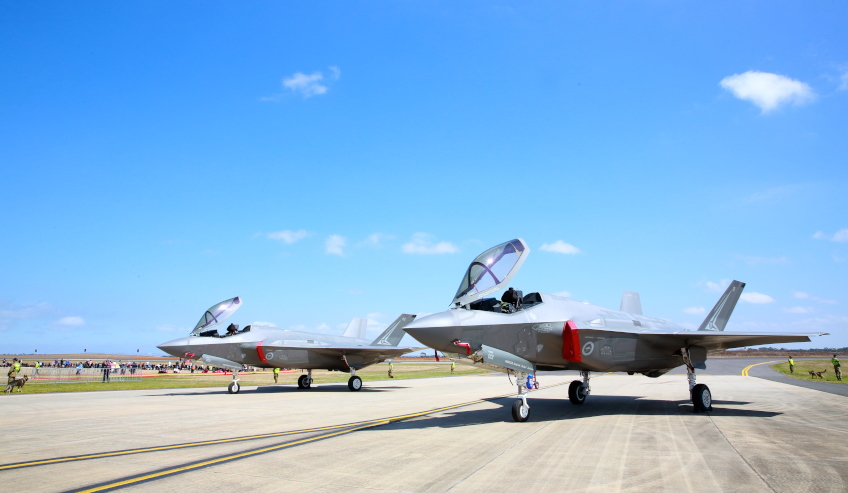While much has been said of the controversial fifth-generation Joint Strike Fighter program, the most expensive military weapons system in history, the Australian and American program leaders have not shied away from the difficulties and risks they are encountering.
To continue reading the rest of this article, please log in.
Create free account to get unlimited news articles and more!
Australia will have a total of 72 F-35A aircraft, with the full fleet in service by the end of 2023. Two, AU-001 and AU-002, have been delivered and each cost more than US$120 million.
Over 30 Australian companies have already participated in production supply chains to provide high-end solutions to the JSF capability. The current cumulative total of Australian JSF production contracts is US$681 million and is forecast to reach almost US$4 billion in 2038.
Head of the F-35 Joint Program Office Lieutenant General Christopher Bogdan and Head of the Australian Joint Strike Fighter program Air Vice-Marshal Leigh Gordon discussed the risks of the program while in Australia.
AVM Gordon stated, "There are risks with the program, and it's more than just a set of aircraft that we're talking about here, it's quite a complex activity that we're undertaking."
AVM Gordon said one of the risks that specifically relates to the Australian program is the major base redevelopment of RAAF Base Williamtown for new facilities for the arrival of the Joint Strike Fighter aircraft.
"There's $1.5 billion of facilities work occurring as part of the F-35 program," AVM Gordon said.
Referring to a recent image of the facility upgrade at Williamtown, AVM Gordon said there are "two operational conversion units being built, with a number of simulator bays, [and] a seven aircraft hangar".
"Above that the two hangars that are being put together for 3 and 77 squadron, that'll be two five aircraft bays, and then sitting in front of those is the expansive tarmac that's going to be put in place with the aircraft to be parked with the carports underneath them," he said.
"So clearly there is certainly risk in that program, we're managing that risk, confronting the issues head on, but certainly at this stage I'm quite confident to predict that we'll achieve the IOC [Initial Operating Capability] in December 2020."
Lt Gen Bogdan elaborated on some of the other risks of the controversial program.
"We have risks, we have things we have to sort out. There are challenges ahead," Lt Gen Bogdan said.
Despite the positive performances of the 200 aircraft in the field, Lt Gen Bogdan expressed his concern and disappoint with the performance of the older aircraft.
"The aeroplane today, the 200 aeroplanes out in the field are performing fairly well. Unfortunately, our older aeroplanes that came off the production line some years ago are not performing as well as the newer aeroplanes," he said.
"If you took a look at our newer aeroplanes compared to some of our older aeroplanes, you would see a very significant improvement in their aircraft availability, and their reliability and maintainability. That's a good thing, because what we're doing is we're building newer aeroplanes now, and eventually when we modify those older aeroplanes up to the standards of the newer aeroplanes, we'll have a fleet that's fairly robust."
Lt Gen Bogdan went as far to declare the reliability and maintainability of the older aircraft as "flat", and said there is much room for improvement, particularly in comparison to the newer aircraft.
"Unfortunately, today, the aircraft availability, the reliability and maintainability of the aeroplane is what I would call flat. It's not bad, it's just not getting a whole lot better really fast. Now if you separate out those good aeroplanes, they are getting better faster, but not if you include the older aeroplanes, and we have to work on that. That is a challenge we have on the program, that is a risk on the program, because we need to continue to drive the cost of flying and maintaining the aeroplane down, lower and lower each and every year."
Lt Gen Bogdan also cautioned about the ramp up of the production line, fearing the workload of the manufacturing companies.
"I'm worried about that the ramp up of some of the aeroplanes coming off the production line, while at the same time we have 200 aeroplanes out in the field that we have to support," he said.
"Because those companies that are building pieces and parts for the production line, are the very same companies that we're turning to, to fix older parts on the aeroplane. There is a natural tension and a capacity issue with those industry partners in building new parts for the production line, and fixing the older parts on our aeroplanes in the field. That's a risk, that's a problem we have to work with."
Lt Gen Bogdan said he is also wary of potential software issues of the program such as ALIS, the Autonomic Logistics Information System.
"Software will always be a risk on this program. Now, 10 years from now, 15 years from now," Lt Gen Bogdan stated. "It's just complicated. Lots of software, and the capabilities embedded in that software are just very complicated."
Some of these complications are the stability issues of the software, but the Lt Gen Bogdan is confident the problem will be solved.
"You heard about stability issues on our software six months ago to a year ago, I'm not going to stand here and tell you that's totally fixed and that's never a problem we're going to have to worry about, but what I will tell you is we have a very good understanding of where those problems are, and how to route those problems out, and we're seeing that today in the aeroplanes that we're producing."

 Login
Login







